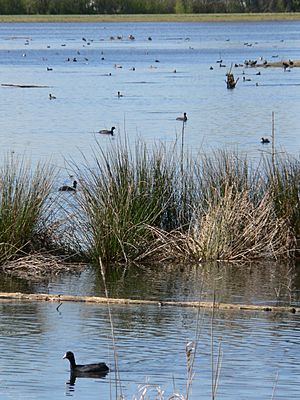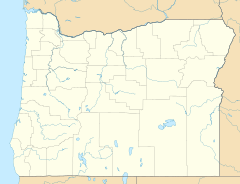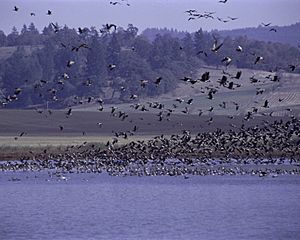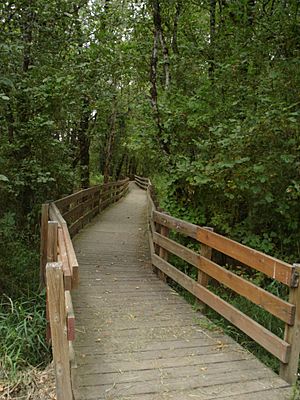Ankeny National Wildlife Refuge facts for kids
Quick facts for kids Ankeny National Wildlife Refuge |
|
|---|---|
|
IUCN Category IV (Habitat/Species Management Area)
|
|
| Location | Marion County, Oregon |
| Nearest city | Salem, Oregon |
| Area | 2,796 acres (1,132 ha) |
| Established | 1965 |
| Governing body | U.S. Fish and Wildlife Service |
| Website | Ankeny NWR |
Ankeny National Wildlife Refuge is a special place for wildlife in Oregon. It's located in the rich Willamette Valley, about 12 miles (19 km) south of Salem. This valley used to have many different kinds of wildlife habitats, including large wet areas and winding rivers.
Today, the Willamette Valley has a mix of farms and growing cities. This means there are fewer natural spaces left for wild animals. Ankeny National Wildlife Refuge helps protect some of these important areas.

The refuge is found in open farmland where the Santiam and Willamette rivers meet. The Willamette Valley has mild, rainy winters, which is perfect for birds that spend the winter here.
The refuge covers about 2,796 acres (11.3 km²). This land includes:
- 1,700 acres (7.1 km²) of farmland that grows food for geese in winter.
- 600 acres (2.4 km²) of riparian zone forests, which are forests along rivers and streams.
- 500 acres (2.0 km²) of shallow seasonal wetlands, which are wet areas that might dry up in summer.
Contents
Why Ankeny is Important for Geese
Ankeny National Wildlife Refuge, along with other refuges in the Willamette Valley National Wildlife Complex, has a main goal: to provide great winter homes for geese. They especially focus on a special type of goose called the dusky Canada goose (Branta canadensis subsp. occidentalis).
Dusky Canada geese are unique because they don't travel as far as most other Canada geese. They nest in Alaska and spend almost all their winters right here in the Willamette Valley. Sadly, their numbers have gone down because they've lost their homes, and due to predators and hunting.
Helping Geese Find Food
The refuges in the Willamette Valley have a special farming program. Farmers work with the refuge to plant fields with high-protein grasses like ryegrass and fescue. These grasses are perfect food for the seven types of Canada geese that winter here, especially the dusky subspecies. Some fields are planted every year, while others are mowed or burned to make sure the grasses are tender and nutritious.
Providing Safe Resting Spots
Geese also need water for resting and finding food. Many of the refuge's wet areas are natural. Others are created or improved with dikes and levees. Some wet areas that were drained long ago have been restored. This helps create more diverse and appealing homes for wildlife.
Most of the wet areas are managed as "moist soil units." This means they encourage the growth of wetland plants like millet and smartweed. These plants are important food for waterfowl and other animals.
By resting in quiet, undisturbed areas on the refuge, wintering geese can regain their energy. This energy is super important for their long migration back north and for nesting. Having these safe spots also helps keep the geese from eating crops on nearby private farms.
To keep the geese safe and undisturbed, some parts of the refuge are closed to visitors when the geese are there. This helps minimize human disturbance. The refuge has also been working hard to restore and expand its riparian forests and wet prairie habitats.
Other Wildlife and Activities
Ankeny NWR is also home to many other kinds of birds, as well as mammals, reptiles, and amphibians. It's a great place to see different animals!
Visitors can enjoy several activities at the refuge:
- Watching wildlife
- Taking photos of nature
- Hiking on trails
- Learning about the environment
There are specific places for visitors, like the Ankeny Hill Overlook and the Eagle Marsh Kiosk. You can also explore trails such as the Pintail & Egret Marsh Boardwalk and the Rail Trail.
Refuge Goals
The main goals for Ankeny National Wildlife Refuge are:
- To provide winter homes for the dusky Canada goose and other migrating waterfowl.
- To protect and help threatened and endangered species.
- To keep habitats safe for native animals and maintain natural diversity.
- To offer opportunities for environmental education, research, and wildlife-focused recreation.
Things You Can Do
- Hiking
- Watching wildlife
- Environmental education
- Photography
Images for kids





